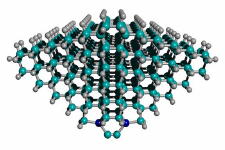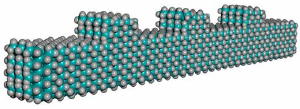Diamond Mechanosynthesis (original) (raw)
What is Diamond Mechanosynthesis?
Diamond mechanosynthesis (DMS), or molecular positional fabrication, is the formation of covalent chemical bonds using precisely applied mechanical forces to build diamondoid structures. DMS may be automated via computer control, enabling programmable molecular positional fabrication.
Atomically precise fabrication involves holding feedstock atoms or molecules, and a growing nanoscale workpiece, in the proper relative positions and orientations so that when they touch they will join together in the desired manner.
In this process, a mechanosynthetic tool will be brought up to the surface of a workpiece. One or more transfer atoms are added to, or removed from, the workpiece by the tool. Then the tool is withdrawn and recharged. This process is repeated until the workpiece (e.g., a growing nanopart) is completely fabricated to molecular precision with each atom in exactly the right place. Note that the transfer atoms are under positional control* at all times to prevent unwanted side reactions from occurring.
The first experimental demonstration of true mechanosynthesis, establishing covalent bonds using purely mechanical forces on silicon atoms, not carbon atoms, was reported by Oyabu and colleagues in 2003. The first DMS patent was granted in the U.S. on 30 March 2010 to Robert A. Freitas Jr.
* More precisely, it is the handle structure which directly receives the positional control and the applied forces, not the attached transfer atoms. But a side effect of positionally contraining the handle is that the moiety at the tip is also, to some degree, positionally constrained, far more so than, say, a free-gas or solution-phase moiety.

- Annotated technical bibliography of research work on diamond mechanosynthesis
- Landmark minimal toolset paper on DMS by Freitas and Merkle in 2008
Unlike macroscale robots, nanoscale manipulators and nanoscale products at intermediate stages of fabrication or assembly will be buffeted by thermal noise. Atoms and molecules are in a constant state of wiggle and jiggle. The higher the temperature, the more vigorous the motion. One technique that can position individual atoms is the scanning probe microscope (SPM), in which a sharp tip is brought down to the surface of a sample, generating a signal that allows the probed surface to be mapped, crudely analogous to a blind person tapping with a cane to sense the path ahead. Some SPMs literally push on the atomic surface and record how hard the surface pushes back, or connect the probe and the surface to a voltage source and measure the current flow when the probe gets close to the surface. A host of other probe-surface interactions can be measured and are used to make different types of SPMs.
Besides mapping, the SPM can also change a surface – for instance, by depositing individual atoms and molecules in a desired pattern. In one well-publicized case in 1989, scientists arranged 35 xenon atoms on a nickel surface to form the letters identifying their employer as “IBM”. But this SPM manipulation required cooling to 4 degrees above absolute zero – hardly ideal conditions for large-scale manufacturing. SPMs also have error rates high enough to require relatively sophisticated error detection and correction methods. While these systems can move around a few atoms or molecules, they can't manufacture large amounts of precisely structured diamond of the kind that might be used to build a molecular robotic arm.
Today’s SPMs also are much too slow. In nature, bacterial ribosomes take at least 25 milliseconds to add a single amino acid to a growing protein under positional control. If a nanofactory production line or molecular assembler is to manufacture a copy of itself (or its own mass) in about a day, and if this requires about a hundred million atom-placement operations, then each such operation must be completed in ~1 millisecond, a somewhat faster operating frequency than the ribosome. Today’s SPMs, by contrast, may take up to an hour to arrange a single atom or molecule. Major advances in SPM speed and accuracy will be required to achieve reliable diamond mechanosynthesis, and such advances are an explicit experimental goal of the Nanofactory Collaboration.
To maintain its proper position, the tooltip handle and other supporting structure (and the workpiece upon which the DMS tool labors) must be extremely stiff. The strength and density of a material depends on the number and strength of the bonds that hold its atoms together, and on the massiveness of the atoms. The element that best fits these criteria is carbon, which is both lightweight and forms stronger bonds than other elements. The carbon-carbon bond is especially strong. Each carbon atom can bond to four neighboring atoms. And carbon atoms can make the stiffest material available: diamond. In diamond, a dense network of strong bonds creates a strong, relatively lightweight and very stiff material.
The working environment for diamond mechanosynthesis is often assumed to be an ultra-high vacuum (UHV), though DMS performed in a noble gas fluid or other chemically inert fluid environment is not inconceivable.
Using computer-automated tooltips performing positionally-controlled DMS in lengthy programmed sequences of reaction steps, we may be able to fabricate simple diamondoid nanomechanical parts such as bearings, gears, struts, springs, diamond logic rods (illustrated at right), and casings to atomic precision. While it is likely that some basic diamondoid structures may be producible using self-assembly techniques from conventional synthetic chemistry, it seems unlikely that multifeatured, highly strained, or complexly interleaved structures can be fabricated without employing some form of positional control.



